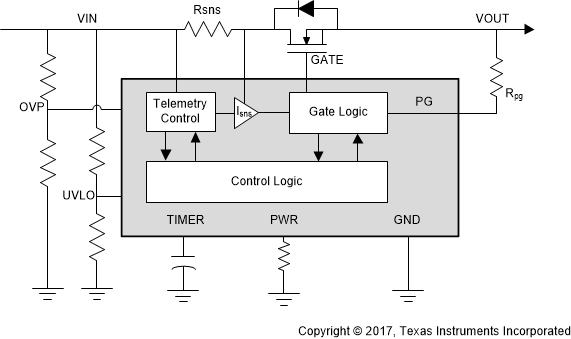SLVA927A November 2017 – April 2019 LM25066A , LM25066I , LM5050-1 , LM5051 , LM5064 , LM5066 , LM5067 , LM5069 , LM66100 , LM74500-Q1 , LM74700-Q1 , TPL7407LA , TPS1H100-Q1 , TPS1HA08-Q1 , TPS2113A , TPS2115A , TPS22810 , TPS22915 , TPS22916 , TPS22918 , TPS22971 , TPS22990 , TPS23525 , TPS2412 , TPS24751 , TPS24770 , TPS25942A , TPS2595 , TPS2660 , TPS27S100 , TPS2H160-Q1 , TPS4H160-Q1 , ULN2003A
4 Hot Swap
 Figure 5. Hot Swap Block Diagram
Figure 5. Hot Swap Block Diagram Hot Swap controllers drive an external MOSFET that protects the system against hot swap events. Hot Swap controllers do not integrate a MOSFET as eFuses do. The external MOSFET allows hot swap controllers to operate at higher voltages and currents than eFuse devices. The controller monitors the gate voltage of the external FET and adjusts the voltage depending on the situation. When the device is inserted into a live power system, the controller measures the inrush current across RSNS. If the value exceeds the programable current limit, the gate voltage is lowered and limits the current passing downstream. If the power dissipated across the FET exceeds the programmable power limit, then the gate voltage is reduced to lower the current flowing through RSNS. The overvoltage and undervoltage pins also clamp the voltage whenever the input voltage is not within specified thresholds.
To ensure that the external MOSFET remains within safe operating area (SOA), the hot swap controller regulates the current limit at higher VDS voltages. The device also includes an assortment of telemetry that monitors the operating conditions. The Power Good (PG) signal turns on whenever the power rail reaches regulation, and some hot swap controllers contain PMBus monitoring that allows real-time feedback on the device status.
Since hot swap controllers operate by controlling an external RSNS and MOSFET, they do not contain an innate current limit. The external components allow you to customize the solution size and power requirements to fit their application.
Table 5. Hot Swap Examples(1)
| DESCRIPTION | DEVICE | RECOMMENDED VOLTAGE RANGE | PACKAGE |
|---|---|---|---|
| 18-V analog devices, small footprint, easy-to-use | TPS247xx | 2.5 V to 18 V | SOP or QFN |
| Meets 240-V requirements for high-end applications, similar to TPS247xx | TPS2477x | 2.5 V to 18 V | QFN |
| PMBus and I2C communication, balance between efficiency and accuracy | LM25066A,
LM25066I |
2.9 V to 17 V | QFN |
| Higher voltage applications, PMBus and I2C communication, external FET temperature and failure sensing | LM5066 | 10 V to 80 V | PWP |
| Higher voltage applications, SOA protection, current limit | LM5069 | 9 V to 80 V | SOP |
| Negative voltage support, SOA protection, PMBus and I2C communication | LM5064 | –10 V to –80 V | SOP |
| Negative voltage support with dual current limit, soft-start disconnect, ORing support, –200 V maximum rating | TPS2352x | –10 V to –80 V | SOP |
| Circuit breaker function for severe current events, programmable fault timer, PG output | LM5067 | –9 V to –80 V | SOP |